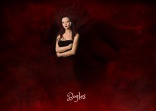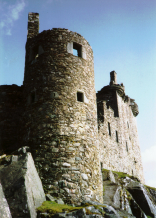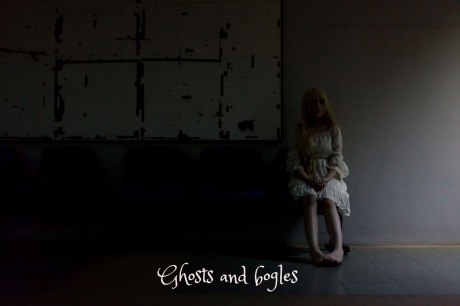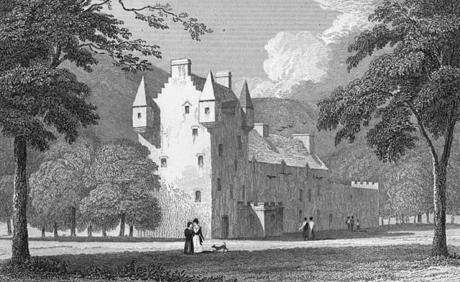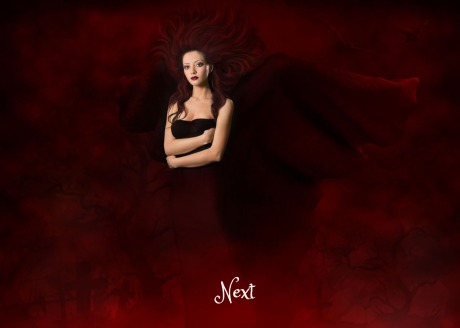The Meggernie Haunting
A GHOST OF TWO HALVES
‘I was awakened in the night by what appeared to be a burning kiss, it appeared to scorch the flesh through the cheek bone. I jumped up in bed and distinctly saw the upper half body of a Lady pass from the side of my bed, go along the room and through the door that was screwed up, as if going into Beau’s room.’
So wrote Reverend E. J. Simmons in a letter of the 7th of January 1882 about his ghostly encounter at Meggernie Castle in Perthshire.
Simmons and his friend, Beaumont Featherstone (who wrote a similar letter about his experiences in January 1883), had visited the castle around twelve or thirteen years previously (1869 or 1870) when the castle was owned by Mr Herbert Wood, a friend of Featherstone.
According to letters from the two visitors, they claimed to have heard no rumours or tales of ghostly sightings prior to their visit. They were to be housed in two large bedrooms in the original tower as the rest of the accommodation in the castle was occupied. There was a connecting door through a closet between the two rooms which could not be opened.
Simmons and Featherstone were in a party visiting the Highlands of Scotland for shooting – particularly grouse – and fishing and all things ‘Scotch’, all of which were very popular during the Victorian era.
Simmons wrote that he was delighted with his room as it had windows to the north and south, giving him views over the park land to the mountains beyond.
Both men went to their respective rooms after a tiring day and Simmons fell asleep quickly only to be woken in the wee small hours by the ghost’s hot and painful kiss.
Simmons’s account noted that the apparition appeared to pass through the door to Featherstone’s room but he ‘... jumped out of bed and went at once to the door and tried it. It was as firm as a lock ...’. He then checked his cheek, expecting to find it blistered from the hot kiss, but there was no mark, although it ached as if it was burnt.
At that time Simmons did not call on his friend or awaken any of the other guests or members of the household, but instead, with his trusty lamp in his hand, in the manner of all worthy Victorian explorers, went to the stairs outside his room in search of the mysterious apparition.
When he found no evidence of either a corporeal or spiritual visitor, he returned, somewhat wearily, to his bed feeling ‘cold and uncomfortable’.
In the morning when the two friends woke, it transpired that Simmons was not alone in experiencing a broken night’s sleep.
According to Simmons, Featherstone reported that he too had had a terrible night and his account has him being woken by the ghost which then disappeared into the closet; he also noticed that the apparition had a beautiful face, but one that was spoiled by a ‘look of despair’.
At breakfast, where the guests would convene over a leisurely hour or two, Simmons was keen to regale his exciting news but ‘a look from Mrs Herbert Wood stopped me, for she was afraid it would alarm her guests’.
The two men then appear to have reported their nocturnal experience to their hosts as, according to Simmons, they were told about a previous female guest who had disturbed the whole household by wakening everybody in the middle of the night complaining that she had felt a woman lying down beside her.
Also a servant girl, working in the kitchen, had claimed to have seen the lower half of a woman walking along the passage. It was said that a similar apparition had been seen several times, covered in blood, either beside an avenue of lime trees in the castle’s parkland or in the local graveyard.
Featherstone left the castle quite soon after but Simmons stayed on for several more days, although he had been moved to a different bedroom.
About ten days later, while he was sitting writing in one of the other rooms, the heavy, iron-studded oak door opened and the room became icy cold. As he walked along a passage, he had another ghostly encounter and noticed the apparition of the same face, which he had seen in his bedroom, looking in through a window.
In his 1882 letter about the experience, Simmons mentioned that the local servants would not stay in the old part of the castle and refused to go near the graveyard at night, as there had been many sightings of a female apparition, walking or sitting around the gravestones.
Indeed Simmons seems to have tried to do some research amongst the local community who appeared reluctant to elaborate – or repeat old stories to strangers:
‘The people seemed to dislike talking on the subject extensively and looked angered when questioned about it’.
Despite this lack of communication, Simmons was able to suggest that the origins of the sightings may have related to a legend about one of the Menzies lairds of Meggernie, who murdered his young wife in a fit of jealous rage.
Meggernie Castle, in the picturesque Glen Lyon, is an imposing sixteenth-century tower house and mansion, located to the north of Killin in Perthshire.
It was one of several strongholds built by Colin Campbell of Glen Lyon, one of the branches of the very powerful Campbell clan. In later years the property passed to Menzies of Culdares and the murderous legend relates to one of this family.
One of the lairds, the date is not specific, married a particularly attractive and young bride. Although there were no tales of infidelity, Menzies was unable to trust his wife and his jealousy grew to such an extent that he was unable to believe anything she did or said. Actions were interpreted as suspicious until finally he snapped and attacked and murdered the poor woman.
In an attempt to conceal the deed, and delay any punishment, Menzies cut the corpse in two and hid her remains under the floor or in a closet in one of the rooms in the tower, depending on the version of the story. This room later became known as the ‘haunted room’.
Menzies then informed his staff and other inquirers that his wife was visiting relatives and that they then intended to make a trip to the continent and would be away for some time.
The castle was shut up and it was several months before Menzies returned with the sad news that his wife had drowned during their visit to Europe.
Menzies then seems to have tried to bury his wife’s remains, which would not have been a particularly pleasant task as the corpse would have certainly been in a decayed and rotting condition after several months in a chest or closet.
He buried the bottom half in the graveyard, but the disposal of the upper half of her torso was less successful as by whatever means, naturally, accidentally or on purpose, Menzies perished himself before he moved it.
He was found dead one morning in the tower; some suggest that he may have died of a heart attack after the exertions of moving the corpse, that he may have fallen, that he was slain by his wife’s suspicious relatives – or that he was frightened to death by the apparition of his murdered wife.
According to legend, it was from that point that strange manifestations began to be recorded, and that the apparition had two parts: the top half of a woman in the upper rooms in the tower and the lower half, wearing a blood-splattered dress, seen on the ground floor, outside in the castle grounds, or in the graveyard.
The Simmons/Featherstone accounts seem to have been similar to other, later, versions.
The wife of a Colonel Kinloch Grant, who had been staying at the castle one autumn, reported waking in the night to see the apparition of a woman bending over her.
In 1928 Dr Douglas MacKay from Aberfeldy, who was staying in one of the lower rooms in the old tower, claimed to have heard footsteps outside his room and saw the upper part of the apparition floating near the ceiling, which emitted a pink glow.
During renovation work on the castle in the early years of the twentieth century, it is said that the upper bones of a skeleton were discovered beneath the floor in one of the upper chambers, and, although the remains were buried, hauntings and manifestations continued to be reported, including banging and knockings. It is thought a rapping sound heralded an appearance of the ghost.
Simmons’s letter emphasised that he was not superstitious, that he found the old tower charming, and enjoyed the novelty of the whole castle, despite the original part being gloomy.
Featherstone, in his letter, seemed less romantic about the whole event than his friend; indeed he was a little defensive, as he wrote,
‘I don’t care about talking about it to anyone and I hate writing about it and never have before, as I don’t like being laughed at for the reason that it [was] not tosh’.
He recounted that he was awoken, around 2.30 in the morning, by a pink light and saw a female standing at the foot of his bed. His initial reaction was that it must have been the housekeeper: it was not uncommon for domestic staff to appear in guests’ bedrooms in the middle of the night but usually it would be by some prior, secret, arrangement for a completely different type of assignation!
Featherstone described how the ghost came alongside his bed and leaned over him, but when he sat up the apparition retreated into the closet or cupboard that was in the thickness of the wall of the room (and connected to Simmons’s room).
He then took a light and followed in to the tiny closet where he saw only a towel rail. Looking under the bed, he found nothing and he then spent some hours trying to get back to sleep.
He noted that in the morning Simmons looked ‘most unfortunate’ and that was when he first heard Simmons’s account of the hot burning kiss.
Both men noted that the ghost they had seen was only the apparition of an upper torso – neither saw any legs.
Featherstone admitted that he never slept in the old tower again, although he seems to have enjoyed the grouse shooting, which was the main purpose of their visit: they must have been at the castle some time between 12th August and 10th December.
In his letter he also related that recently he had met at a hotel a nameless ‘lady’ who had been at Meggernie and who had also seen the ghost. He claimed that she described it just as Featherstone had seen it, down to the expression on the face and the way the hair was done.
It may be, of course, that the two men collaborated and concocted the whole story, but their ghostly encounters certainly contributed to – or perhaps created – an enduring local legend.
© Martin Coventry 2017
More info on Meggernie Castle from thecastlesofscotland.co.uk





